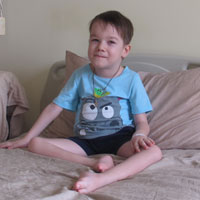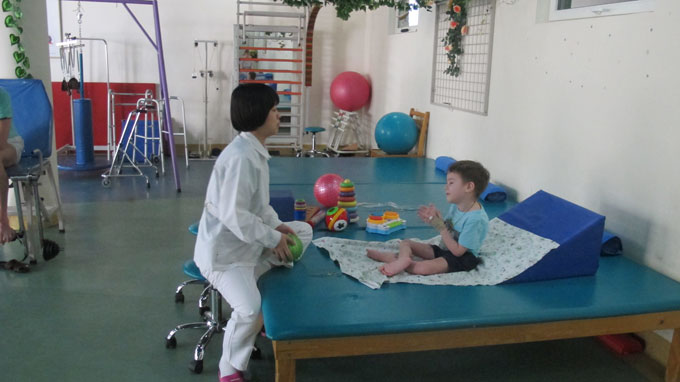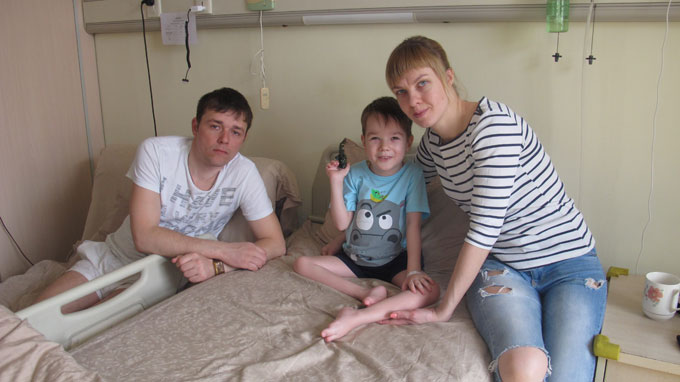Roman Petrukhin-Spinal Muscular Atrophy-(Russia)-Posted on May 3rd, 2016
 Name: Roman Petrukhin
Name: Roman Petrukhin
Sex: Male
Nationality: Russian
Age: 4
Diagnosis: 1. Spinal Muscular Atrophy (SMA) 2. Anemia (Mild)
Date of Admission: Mar.14, 2016
Treatment hospital/period: Wu Medical Center/14 days
Before treatment:
Roman was delivered by cesarean section because he was anoxic while in his mother’s uterus 4 years ago. Apgar score: 7-8. Roman was diagnosed with perinatal cerebropath and ataxia syndrome. When Roman was 7 months old, his parents discovered that he was not able to maintain a sitting position, so they took him to the local hospital where he had a gene examination completed. The results showed there was no exon 7-8SMN on the homozygote sequence, so he was diagnosed with spinal muscular atrophy in March 2012. The doctor prescribed Salbutamoul for oral use for 2 years. At the same time, Roman had physical therapy including massage and swimming but was ineffective. At present, he has thoracic deformity, and is not able to move his upper limbs very well. The muscle power of the lower limbs is between level 0 and level 1.
Roman’s mood was good. His liquid intake and appetite were normal.. He had atrophy of the muscles and he was thin. His urine routine and bowel movements were normal.
Admission PE:
Temperature: 37.1℃, Hr: 120/min, Br: 25/min, Bp: 95/55mmHg. Height: 107cm, weight: 14kg. There was no breakage or hemorrhagic spots on the skin. Roman had thoracic deformity. The respiratory sounds in both lungs were clear. The abdominal movements were weak when he breathed. There were no obvious dry or moist rales. The cardiac rhythm was regular, with no obvious murmur. There was abdominal bulging and the abdomen was soft, with no palpable masses. The liver and spleen were normal. There was no swelling in the lower limbs. The examination results showed signs of slight anemia.
Nervous System Examination:
Roman petrukhin was conscious and alert. His language skills were normal. The insight ability and orientation were normal. Both pupils were equal in size, the diameter was 3.0mms. Both eyeballs could move flexibly and the pupils reacted normally to light stimulus. There was no obvious nystagmus. The vision and vision field were normal. Roman had difficulty shrugging his shoulders and turning his head in either direction. He was able to maintain a sitting position but he was not able to turn over on the bed, sit up, stand or walk. The muscle tension of all four limbs was normal. The muscle power of both upper limbs was at level 3, the gripping strength was at level 3, the proximal muscle power of both lower limbs was at level 1+ and the distal muscle power of both lower limbs was at level 0. The left lower limb was at an angle of 170 degrees and the right lower limb was at an angle of 150 degrees. The left heel was contracted. The right foot was crossed. When Roman bent his hips and knees, he was able to adduct and abduct the lower limbs. When he extended his knees, he was able to move the lower limbs slightly on the bed, and when he bent his knees, he was able to move his lower limbs occasionally. There was no bilateral biceps reflex, radioperiosteal reflex or patella tendon reflex. The Achilles tendon reflex was normal. The bilateral pathological result was negative. Roman was able to do the finger-to-finger test, rapid rotation test and finger-to-nose test correctly but slowly. Roman couldn’t do the heel-knee-shin test. The sensory examination results were normal. There were no signs of meningeal irritation.
Treatment:
After admission, Roman Petrukhin was diagnosed with spinal muscular atrophy. He received 3 neural stem cell injections and 3 mesenchymal stem cell injections to increase the number of normal nerves, repair the damaged nerves and produce new nerves. The treatment provided enough nutrition for the nerves and improved the blood circulation and regulated the immune system. The treatment was accompanied with daily physical rehabilitation training.
Post-treatment:
After 2 weeks of treatment, Roman’s condition was better. He had more power and gained 1kg. He felt more power in his right hand, he was able to bend his left knee easier than before, and when he bent his knees, the adductor muscle power was higher. His resistance improved. He was able to move his knees and ankles better than before. He was able to turn over from the prone position to the supine position. He was able to maintain a sitting position for a longer period of time and his posture while sitting improved.


